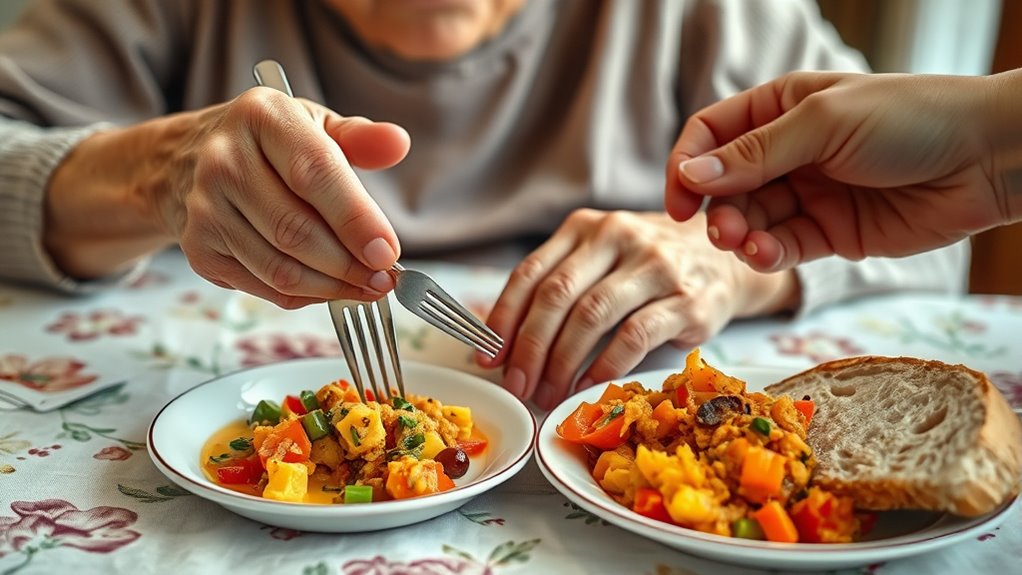Managing nutrition and mealtime in dementia care involves adjusting food textures to reduce choking risks, creating a calm and distraction-free environment, and using familiar routines to ease anxiety. Pay close attention to body language and facial expressions to understand hunger or fullness, and consider adaptive utensils to promote independence. Ensuring hydration and collaborating with healthcare professionals can improve safety and enjoyment. Keep exploring strategies to support your loved one’s well-being and make mealtimes more comfortable.
Key Takeaways
- Dementia often impairs swallowing and appetite, increasing risk of malnutrition and dehydration.
- Simplified, textured foods and consistent routines help manage swallowing difficulties and reduce mealtime confusion.
- Creating a calm, distraction-free environment enhances focus and enjoyment during meals for individuals with dementia.
- Caregivers should observe non-verbal cues and collaborate with healthcare professionals for personalized nutrition strategies.
- Environmental adjustments and adaptive tools support independence and safety, improving overall mealtime experience in dementia care.

Caring for someone with dementia often involves maneuvering complex mealtime challenges that can impact their nutrition and overall health. One of the most effective ways to manage these difficulties is by implementing caregiver strategies that focus on food texture adjustments. As a caregiver, you need to adapt your approach to ensure your loved one eats enough while reducing the risk of choking or frustration during meals. This can be especially important since dementia can cause changes in swallowing, appetite, and food preferences.
Food texture modifications are key to making mealtime safer and more enjoyable. Soft, pureed, or chopped foods are often necessary when your loved one’s chewing or swallowing becomes impaired. You might find that offering mashed potatoes, smoothies, or finely chopped vegetables helps prevent choking and makes swallowing easier. Remember, the goal is to maintain proper nutrition without compromising safety. To do this effectively, you should consider not only the texture but also the appearance and flavor of the food. Bright colors and familiar tastes can help stimulate appetite and encourage eating.
Adjusting food textures with appealing colors and familiar flavors can boost appetite and ensure safety during mealtime.
Caregiver strategies should also include creating a calm, distraction-free environment during meals. Limit noise, turn off the television, and sit with your loved one in a comfortable space. This minimizes confusion and agitation, making mealtime a more focused experience. Consistency in mealtime routines can also help your loved one anticipate and prepare for eating, reducing anxiety and resistance. Using adaptive utensils or plates with high edges can help those with tremors or limited dexterity eat more independently.
Additionally, paying attention to your loved one’s cues is essential. They may not always communicate hunger or fullness clearly, so observe their body language and facial expressions. Offering small, frequent meals or snacks can help ensure they receive adequate nutrition, especially if they tire easily during larger meals. Hydration is equally important, so incorporate fluids into their diet with thickened liquids or smoothies if swallowing issues are present.
Moreover, incorporating glamping principles such as creating a comfortable and familiar environment can help make mealtime more enjoyable and less stressful for your loved one. Finally, always consult healthcare professionals to tailor your approach to your loved one’s specific needs. A speech therapist or dietitian can provide valuable guidance on appropriate texture modifications and nutritional plans. By combining caregiver strategies with appropriate food texture adjustments, you create a safer, more supportive environment that promotes better nutrition and enhances your loved one’s quality of life.
Frequently Asked Questions
How Can Caregivers Improve Mealtime Environment for Dementia Patients?
You can improve the mealtime environment for dementia patients by creating a calm, clutter-free space that reduces sensory overload. Use sensory stimulation like soft lighting and familiar scents to promote comfort. Encourage social interaction by sitting with them, engaging in conversation, and making mealtime a pleasant, social activity. This approach helps patients feel more relaxed and engaged, making it easier for them to enjoy their meals and maintain proper nutrition.
What Are Effective Strategies for Managing Food Refusal?
Are you wondering how to manage food refusal effectively? You can try improving meal presentation to make food more appealing and stimulating your loved one’s appetite. Offer small, manageable portions and maintain a calm, distraction-free environment. Engaging their senses with colorful plates or pleasant aromas can also help. Remember, patience and gentle encouragement often lead to better acceptance, making mealtime more successful for both of you.
How Do Nutritional Needs Change as Dementia Progresses?
As dementia progresses, your loved one’s nutritional needs change; they often have decreased energy requirements but may face issues with nutrient absorption. You’ll notice they need smaller, more frequent meals to meet their energy needs without overtaxing their digestion. Pay attention to their ability to absorb nutrients, and adapt their diet to guarantee they get essential vitamins and minerals. Supporting these changes helps maintain their health and wellbeing.
Are There Specific Diets Recommended for Dementia Patients?
You should consider specialized meal plans for dementia patients, as research shows they can improve nutrition and quality of life. While no single diet is universally recommended, diets like the Mediterranean or DASH may help support brain health. Additionally, incorporating dietary supplements can address nutritional gaps. Always tailor plans to individual needs and consult healthcare professionals to make sure the best support for their advancing condition.
How Can Caregivers Address Swallowing Difficulties During Meals?
You can address swallowing difficulties by consulting with healthcare professionals to assess medication side effects that might worsen swallowing. Offer small, soft, and mashed foods to make swallowing easier, and consider alternative feeding methods like pureed diets if necessary. Guarantee the environment is calm and distractions are minimized. Always monitor your loved one closely for signs of choking or discomfort, and seek guidance on appropriate interventions to keep them safe during meals.
Conclusion
By tackling mealtime challenges head-on, you can turn chaos into calm and confusion into clarity. Every small effort you make could transform a difficult mealtime into a moment of connection and joy. Remember, your patience and understanding aren’t just helpful—they’re powerful enough to change your loved one’s entire day. In fact, your dedication might just be the secret weapon that saves their health, happiness, and dignity—making you a true hero in their care journey.









